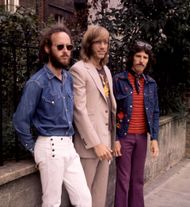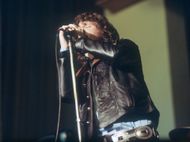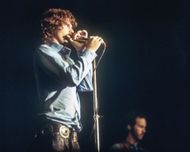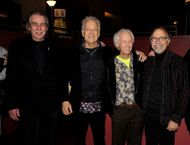In Los Angeles, back in 1965, a time for big shifts in music, a new band, The Doors, started that would make rock music different in sound and thought. The Doors were made when singer and poet Jim Morrison met the man on the keys, Ray Manzarek. Soon, they teamed up with Robby Krieger on guitar and John Densmore on drums.
This wasn't a normal rock band coming together; it was the start of something new. They took the strange vibes of that era and made them into something no one had heard before. The Doors made a type of music that held a deep love for books and the dark side of the mind, with blues mixes and big ideas.
Manzarek's play on the keys, which had bits of old music in it, was what they were known for. This sound mixed well with Krieger's guitar strums (that had hints of Spanish music) and Densmore's drum beats that felt like jazz. Yet, it was Morrison's strange way and deep words that made them really pop out.
The Doors were not just about making hits; they showed the sad and rough parts of the 1960s in the US, leading the big change back then. They left a mark that still hits musicians and fans today who view The Doors as more than just a group, but as a big shift in music and thinking.
Even though The Doors were a team for a short time with their group due to Morrison's death in 1971 at 27, many see them as one of the top bands ever. Albums like The Doors (1967), Strange Days (1967), and L.A. Woman (1971) were more than just music; they showed a young group struggling with who they were, war, freedom, and death.
The band's mark didn't end after Morrison died. His look, magic-like, wild, and full of deep words, turned into a strong sign of rock's big and spooky side. The ones left tried to keep going without him, but it was clear that Morrison was the heart of The Doors.
Yet, the music lived on, found by new listeners who saw meaning in their raw emotion, mesmerizing instrumentation, and deep thoughts. Years later, The Doors remain a key part of rock history, showing that a short-lived flame, if bright enough, can shine forever.
Disclaimer: This article contains the writer's opinion. The reader's discretion is advised!
Here are the top 8 The Doors songs of all time
Picking the best songs by The Doors isn't easy. Their music library brims with trailblazing songs that stretched musical and lyrical limits, each bringing something special, from moody poetry to fiery instrumentals. Their music stands the test of time because it captures the 1960s vibe and explores bigger universal ideas about chaos, longing, freedom, and deep thinking.
Be it a radio hit or a hidden album gem, every song shows off the band's unique mix of bluesy rock, dreamlike images, and bold experimentation. These eight tracks represent some of their most iconic work, songs that not only built the band's reputation but also left a lasting mark on rock music as a whole.
1) Light My Fire
To understand how The Doors' best songs changed music, we need to look at their first album (The Doors) from 1967. This record showed people new ways rock music could sound. One of the best songs on it, Light My Fire, didn't just get people's attention; it showed everyone that hit songs could be different during the crazy 1960s.
The song had long parts without words and was pretty bold, which fit with how people were changing their ideas about culture and boldness back then. Interestingly, British bands like The Rolling Stones helped inspire the song, along with the story in Hey Joe, which Jimi Hendrix made famous.
Light My Fire got to number one on the Billboard Hot 100 and stayed there for three weeks in 1967. The next year, something cool happened: Jose Feliciano did a Latin version that got to number three, and it made people want to hear The Doors' original again. Their version came back on the charts at number 87, which doesn't happen, and shows how much people still loved the song.
Read More: 8 iconic Chester Bennington songs that define his legacy
2) The End
The End didn't start as the big trippy masterpiece we know today, it began as something much simpler: a song about heartbreak. Jim Morrison first wrote it to deal with a personal breakup, but like many of The Doors' best songs, it didn't stay the same. The song grew during the band's stint at the Whisky a Go Go, where each live show pushed it further into new territory.

When they recorded it for their 1967 first album, The End had turned into a 12-minute journey, part poetic goodbye, part dramatic spiral. Its spooky sense of finality gave it a timeless feel, letting people see it through their own endings, whether emotional, deep, or symbolic.
It still packs a punch today: Rolling Stone put it on their 2010 list of the 500 Greatest Songs of All Time, and its creepy, mesmerizing guitar solo landed a spot on Guitar World's list of the 100 Greatest Guitar Solos of All Time.
Read More: Metallica: A journey through heavy metal history
3) Peace Frog
Peace Frog started as an instrumental jam, not a song. The Doors created it during their Morrison Hotel (1970) sessions, their fifth studio album. It didn't become a single. It appeared as the B-side to You Make Me Real in France. People didn't know about it until it showed up on the band's second compilation album in 1972.

What stands out about Peace Frog is how it combines three of Jim Morrison's poems, Dawn's Highway and Newborn Awakening, into something raw and powerful. The band was short on lyrics at the time, so they pushed Morrison to use his own written work. This led to a chilling retelling of a childhood memory: Morrison saw hurt Native Americans after a car crash. He later said this was when he first felt fear.
Robby Krieger's sharp riff and distorted chords kick off the track. Producer Paul Rothchild had told the band not to copy techniques linked to other stars Jimi Hendrix. But Krieger's playing here breaks that rule, adding a trippy edge that makes the intro hard to forget.
Read More: 8 Blackpink tracks that slay every time
4) Touch Me
When The Doors put out Touch Me in 1969 as part of their The Soft Parade album, it marked a bold shift from their earlier, simpler sound. Instead of the moody psychedelia fans expected, this song jumped into full orchestration, with rich strings, bold horns, and a now-famous saxophone solo by Curtis Amy.

This brave move gave the band a smooth, almost movie-like feel, leading to surprise comparisons between Jim Morrison's deep voice and Frank Sinatra's style. While The Soft Parade often splits critics for its genre-mixing and polish, Touch Me stands out as its best track.
The Smothers Brothers TV show performance, now with over 35 million YouTube views, shows the whole spectacle: Morrison's singing, Amy's hot sax, and a band turned into a brass-heavy powerhouse. Whatever you think about the album, Touch Me shows The Doors at their bravest.
Read More: 8 greatest Aerosmith songs of all time
5) L.A. Woman
Not many songs in rock's golden age capture a city's spirit like L.A. Woman does for Los Angeles. The Doors put it out in 1971 as the main track on their last album with Jim Morrison. The song doesn't just sound like a single, it's more of a final goodbye. It's a gritty, powerful farewell to the city that fired up Morrison's imagination and took over his life.
Instead of praising LA in the usual way, Morrison turns the city into a mysterious, alluring woman. He mixes his poetic style with the raw sound of blues-rock. The song's mesmerizing chant, "Mr. Mojo Risin'," is a thoughtful jumble of Morrison's name. This adds a legendary, self-aware twist that seems almost like a prediction, given his death soon after the album came out.
While it didn't climb high on the Billboard Hot 100, stopping at number 52, it struck a chord with both fans and music critics. As time passed, its importance has increased. It's now top-ranked in lists of songs about Los Angeles and stands as one of The Doors' best works.
Read More: 10 greatest rappers who turned rhymes into revolution
6) Hello, I Love You
In The Doors' songbook, Hello, I Love You stirs up the most talk. Unlike their moodier, more out-there songs, this 1968 single goes for a slick, radio-ready sound that some fans see as selling out to the mainstream. Its light, simple words and pop-driven makeup clash with the band's usual poetic depth, making it a sticking point for folks who dig their more complex stuff.

But it goes back to the band's early days, Jim Morrison first wrote it in 1965, said to be inspired by a striking woman he spotted walking on Venice Beach. Even though critics have long said the track copies The Kinks' All Day and All of the Night, guitarist Robby Krieger and drummer John Densmore say the driving beat took cues from Cream's Sunshine of Your Love.
Despite the flak, the song turned out to be a big hit, becoming their second U.S. number one.
Read More: 6 Guns N' Roses songs that defined rock history
7) Love Her Madly
Love Her Madly, the catchy first single from L.A. Woman (1971), came out when The Doors were changing in their music and personal lives. Robby Krieger, the guitarist, wrote the song not just as a rock hit, but to show the ups and downs of love, based on his own relationship full of almost-breakups and emotional battles.

The title, a quirky take on a Duke Ellington saying, shows that mix of wanting and frustration. The song did well in sales, but it also came at a big moment: Jim Morrison was getting ready to go to Paris, not knowing he'd never come back.
Morrison sang Love Her live with the band twice, but those few times showed how the song let him express feelings from the band's usual raw power, maybe a bit lighter, but still hitting deep.
Read More: 10 greatest Bob Dylan songs that stand the test of time
8) L'America
L'America wasn't made first for an album; it actually started as something meant for a movie. The Doors came up with this for Zabriskie Point, a film by Italian auteur Michelangelo AntonioniThey took the song and showed it to the famous director, who kept it with him for a while without putting it in.
The Doors finally selected it as a track, which means the song eventually found its place on an album instead of in a film. A geographical love story isn't actually what the title hints at, so that’s a bit misleading for sure. The lyrics come off odd and almost puzzle-like, with lines such as 'trade some beads to us' that don't talk about a real location; more like it points towards old times when explorers or even conquerors were grabbing land and gold from others.
As if in the middle of a blues movie, the rejected lover would have felt completely strange and mysterious. The song draws up ideas of shadows and strange old adventurers, not really the sunny parts. They knew how to keep picking up ideas no one else seemed to want, turning them into wild and myth-filled songs; this one is like that, too.
Read More: Top 10 Coldplay songs of all time
The Doors' music list is a wild, deep, and strange trip through late '60s rock. With only six main albums made with Jim Morrison, their work mixes blues, wild mind vibes, and dark show-like feels into a sound that you know right away. From the first big hit to the tough goodbye of L.A. Woman, The Doors caught both the mess and loveliness of their time, leaving a mark that feels like it will last and stay wild.
Keep reading SoapCentral for more informative content!
Also Read: Top 6 J. Cole songs you can't miss
